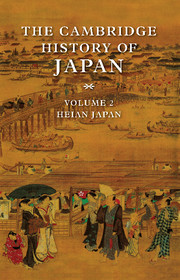Book contents
- Frontmatter
- Introduction
- 1 The Heian court, 794–1070
- 2 The capital and its society
- 3 Land and society
- 4 Provincial administration and land tenure in early Heian
- 5 Chinese learning and intellectual life
- 6 Aristocratic culture
- 7 Aristocratic Buddhism
- 8 Religious practices
- 9 Insei
- 10 The rise of the warriors
- Works cited
- Glossary-index
- Japan in the Heian period"
- References
3 - Land and society
Published online by Cambridge University Press: 28 March 2008
- Frontmatter
- Introduction
- 1 The Heian court, 794–1070
- 2 The capital and its society
- 3 Land and society
- 4 Provincial administration and land tenure in early Heian
- 5 Chinese learning and intellectual life
- 6 Aristocratic culture
- 7 Aristocratic Buddhism
- 8 Religious practices
- 9 Insei
- 10 The rise of the warriors
- Works cited
- Glossary-index
- Japan in the Heian period"
- References
Summary
Social and economic change in premodern times is seldom rapid. But even by premodern standards, change in rural Heian Japan must at first glance seem glacial. Population did increase moderately and with it the area of land under cultivation. Millet gave way to barley as the second grain most grown, but rice retained its place as the primary and most prestigious grain. Irrigation networks, both simple and intricate, grew to feed the expansion in arable land, but with no discernible advance in irrigation technology – indeed, the great state-sponsored water projects of previous centuries found no echo in the Heian period. Provincial handicraft industry grew but little, and there may even have been a decline in the production of silk. House construction remained little changed through most of the country, although in the home provinces there may have been some shift from excavated floors (“pit dwellings”) to raised foundations. All in all, there is little to show for the passage of four centuries.
Or so it must seem to the modern observer. Yet to an eighth-century peasant, agricultural life in twelfth-century Japan would have seemed significantly altered. Iron tools were much more abundant, and included tools and uses unfamiliar to him. Households would have seemed smaller and less independent than in his own age, and the force of local elite families on economic life much stronger. Most of all, he would have found a dramatically changed tax structure, with taxes now managed by an extensive class of local, regional, and provincial notables and officials whose powers, initiatives, and frequently only quasi-official status would have struck him as bewildering and, no doubt, intimidating.
- Type
- Chapter
- Information
- The Cambridge History of Japan , pp. 183 - 235Publisher: Cambridge University PressPrint publication year: 1999
References
- 4
- Cited by



